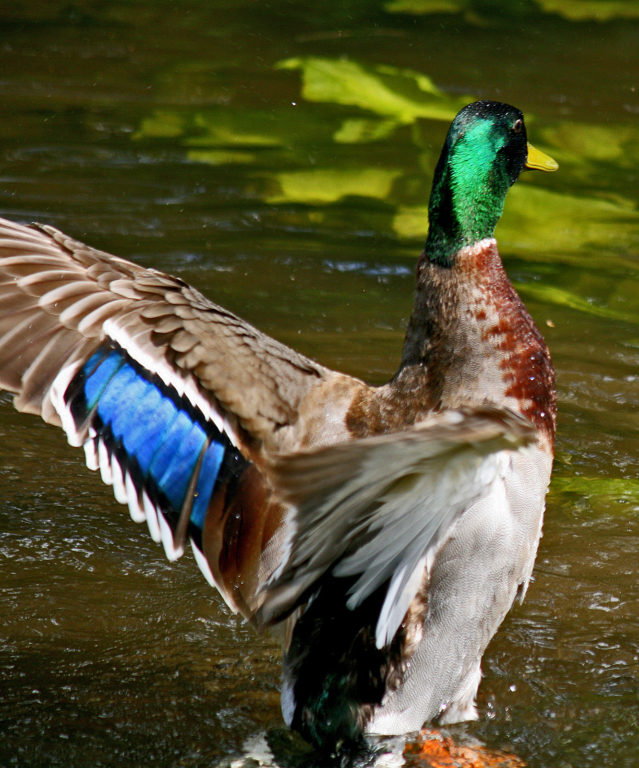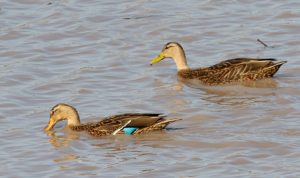The unspeakable sex lives of puddle ducks

The mallard drake, both a canard and a connard. Photo: Rror, Creative Commons, some rights reserved
My francophone wife is often amused as I commence à apprendre la langue, like the time I said connard when I meant canard. For the monolingual English-speakers out there, canard means duck, while the rough equivalent of connard is a word that rhymes with “spithead,” and that you don’t want your kids to say. But where mallards and other puddle-ducks are concerned, the two are related. The drake (male) can be an absolute connard sometimes.
The Darwinian principle “survival of the fittest” is not always about who wins the antler fight or arm-wresting contest. Fitness means being well-suited to one’s environment so as to live long enough to reproduce and thus pass on one’s DNA. Above all else, it means being adaptable.
The mallard, perhaps the most recognizable duck in North America with the drake having a glossy green head, bright orange bill and prim white collar, may be the fittest species ever. In fact, University of Alberta biologist Lee Foote has called them “the Chevy Impala of ducks.” For those under 30, the once-ubiquitous Impala was an all-purpose, nearly bullet-proof sedan.
Native to North and Central America, Eurasia and North Africa, the mallard (Anas platyrhynchos) has been introduced to South America, Australia, New Zealand, and South Africa. It might be more serviceable even than the Impala. The International Union for Conservation of Nature, a group dedicated to the sustainability of natural resources, lists it (the duck, not the car) as a “species of least concern.” This designation sounds apathetic, but there is concern in places such as South Africa and New Zealand, where mallards have become invasive.
Unlike with automobiles, where hybrids are good but rarely free, mallard hybrids are so common that other ducks may soon disappear as distinct species. Typically, a defining feature of a species is the fact it is unable to cross with other species to produce offspring, or at least not fertile ones. Mallards, evidently, have not read the literature. I hate it when nature does that.
Mallard hyper-hybridization is due to the fact that they evolved in the late Pleistocene, recent in evolutionary terms. Mallards and their kin “only” date back a few hundred thousand years. Animals originating millions of years ago have had time to spread out and develop unique adaptations, often including physical and behavioral changes that render them incompatible with once-related species.

A breeding pair of Mexican ducks, no longer a separate species due to mallard interbreeding. Photo: Gary L. Clark, Creative Commons, some rights reserved
Mallards frequently mate with American black ducks, but also breed with at least a dozen other kinds, in some cases resulting in the loss or near extinction of species. According to the Global Invasive Species Database (GISD), “As a consequence [of mallard interbreeding], Mexican duck is no longer considered a species and less than 5% of pure non-hybridized New Zealand grey ducks remain.”
Mallards are a type of puddle or dabbling duck, tipping their heads under water to feed on mollusks, insect larvae and worms, as opposed to diving after prey. They also eat seeds, grasses and aquatic plants. Well-adapted to humans, they seem just as pleased to snap up day-old bread in city parks.
Their mating strategy, while not responsible for their success, may be emblematic of it. In about 97% of the planet’s bird species, mating is a brief, external event in which the male’s stuff gets passed to the female by the two touching their back ends together in what is called (by humans at least) a “cloacal kiss.” The cloaca is a bird’s all-purpose opening used to pass eggs, feces and whatever, as needed. This PG-13 performance sounds anything but romantic.
Certain ducks went to the other extreme, dabbling in X-rated, violent sex. Puddle-duck males can have members longer than their bodies, which certainly puts things in perspective for us guys. Also, a number of mallard drakes copulate with each hen, sometimes at once, occasionally resulting in injury or (rarely) death of a female.

“This seems like a bad way to run a species.” Photo: AnemoneProjectors, Creative Commons, some rights reserved
This seems like a bad way to run a species, with rapist-drakes (lower-case d) killing females. But there is some sense to it. Females have been observed rounding up guy ducks who seem to have nothing better to do. The reason a mallard hen might barnstorm drake hangouts to get them to follow her has to do with lifespan. In contrast to the Canada goose, known to live 10 to 25 years in nature, wild mallards have an average lifespan of 3-5 years. This means a high percentage of females, which begin breeding at age 2, will mate only once in their life. Multiple copulations will ensure the hen’s eggs will be fertile.
And girl-ducks have a secret strategy—once a hen gets the attention of the guys, she can pick the duckling-daddy. If a male does not suit her, she will guide the loser-drake’s penis into a vaginal dead-end until he is done, a copulation fake-out. The lucky drake will be allowed to go the whole nine yards. So to speak—I doubt it’s that long.
Obviously, mallards don’t need our help finding food. In most cases it is not a good idea (and local by-laws may prohibit it) to feed waterfowl, which can increase water pollution and diseases, even some that can affect humans. So-called “swimmers’ itch,” a duck parasite that can afflict beachgoers, is the least of them. The GISD states “…mallards are the prime long-distance vector of H5N1 [bird flu] since they excrete significantly higher proportions of the virus than other ducks while seeming immune to its effects…their extreme wide range, large populations, and tolerance to humans provides a link to wild waterfowl, domestic animals, and humans rendering it a perfect vector of the deadly virus.”
The short lifespan of mallards drove the species to develop strategies that include harsh behaviour. We humans have no such excuse. It would be ducky if we could agree never to act like a connard, but that is not realistic in a complex world. Maybe we could at least try to become bilingual.
Paul Hetzler is a horticulture and natural resources educator with Cornell Cooperative Extension of St. Lawrence County.
Tags: ducks, mating behavior, nature







